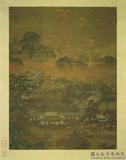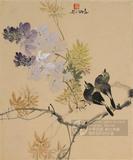五代南唐周文矩仕女圖 軸
推薦分享
資源連結
連結到原始資料 (您即將開啟新視窗離開本站)後設資料
- 資料識別:
- 故畫000019N000000000
- 資料類型:
- 類型:繪畫
- 型式:靜態圖像
- 著作者:
- 周文矩
- 主題與關鍵字:
- 仕女 梧桐 貓(貍奴) 奇石 竹 月季 玫瑰 薔薇 黃鸝 欄杆 文房用具 蝶蛾
- 出版者:
- 數位化執行單位:國立故宮博物院
- 格式:
- 本幅 180.9x102.1公分、全幅 104.3公分
- 關聯:
- 石渠寶笈三編(乾清宮),第一冊,頁477 &*故宮書畫錄(卷五),第三冊,頁18&*故宮書畫圖錄,第一冊,頁67-68&*周文矩(西元十世紀)建康句容(今南京)人。仕後主李煜為翰林待詔,善繪冕服車器,尤工人物仕女。所作人物,線條率皆細勁曲折,圓潤流暢,間作顫動之勢,飄逸自若,不令墮入吳(道子)曹(弗興)之舊習,故能自成一家面目。至若綺羅仕女,雖近承唐代周昉,惟其纖細秀麗,益有過之。本幅畫桐陰仕女憑欄展卷,旁見一貍奴相伴。圖中並無名款,觀其衣紋,轉折剛健,與文矩風格相去遠甚,當屬後世收藏者擅自附名,乃有此標題。 &*Chou Wen-ch', a native of Ch'-jung, Chien-k'ang (modern Nan-king), served the Southern T'ang ruler Li Yu as a Painter-in-Attendance at the Hanlin Academy. He excelled at paintings elaborate costumes and carriages, but was famous for his figure paintings, especially those of women. These he drew with delicate twisting, segmented lines of great fullness and fluidity, sometimes employing a graceful, waving line. He did not just merely slavishly emulate the styles of the famous painters Wu Tao-tzu (fl. ca. 710-760) or Ts'ao Pu-hsing (fl. third century) but created his own unique manner. His paintings of beautiful women reflect the influence of Chou Fang (fl. 780-804) but are even lovelier and finer than his. In the shade of a firmiana tree a young woman, a cat by her side, casually leans against a balustrade, reading a book. The painting does not bear the artist's signature and was probably given its current attribution by a later collector. In terms of brushwork, the forceful turning and twisting lines that model the woman's robes are far from Chou-ch's style. &*1.劉芳如,〈明人仕女圖(舊傳五代南唐周文矩)〉,收入劉芳如、張華芝主編,《群芳譜 — 女性的形象與才藝》(臺北:國立故宮博物院,2003年初版一刷),頁49。 2.劉芳如,〈五代南唐周文矩仕女圖〉,收入國立故宮博物院編輯委員會編,《仕女畫之美》(臺北:國立故宮博物院,1988年四月初版),頁75。
- 管理權:
- 國立故宮博物院
授權聯絡窗口
- 國立故宮博物院圖像授權、出版授權、影音資料授權-申請流程說明
http://www.npm.gov.tw/zh-TW/Article.aspx?sNo=03003061






